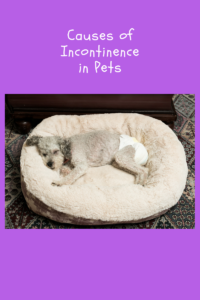 When coming home to suspicious yellow puddles around the house, an owner must turn into an instant sleuth, and we are here to help. Furry Footsteps LLC is exploring the reasons for cat and dog medical incontinence, and what to do about it when discovered. While behavioral urination is always a possibility when you find urine around the house, we will be exploring incontinence due to medical issues. Please read on for more information!
When coming home to suspicious yellow puddles around the house, an owner must turn into an instant sleuth, and we are here to help. Furry Footsteps LLC is exploring the reasons for cat and dog medical incontinence, and what to do about it when discovered. While behavioral urination is always a possibility when you find urine around the house, we will be exploring incontinence due to medical issues. Please read on for more information!
What is Medical Incontinence?
Medical incontinence is loss of bladder control due to a specific medical condition or illness. Often the circumstances for finding urine can be a defining factor in diagnosing. Any of the following are possible signs that your dog or cat has a medical condition:
- Leaving a puddle of urine where they lay down
- Any urine outside the litterbox
- Wet hair on their stomach or hind legs
- Redness or swelling around their genitals
- Damp fur or skin around their genitals
- Dribbling of small amounts of urine when walking around
- Leaking urine when picked up or pressure put on stomach
If your cat or dog is deliberately urinating on inappropriate objects, like when a dog marks territory by lifting a leg, this can be considered behavioral urination. A dog can also display submissive urination, seen by laying down or rolling over and urinating during a stressful encounter or greeting.
If you see any type of inappropriate urination, it is always a good idea to bring it up with your veterinarian just in case the cause is medically related. If your veterinarian finds no medical reason for their unfortunate peeing behavior, it is time to turn to behavioral training.
What Causes Incontinence?
There are many causes for incontinence, and it can found in all different ages, though most often in middle-aged to older female pets. For an exact reason a trip to your neighborhood veterinarian is required, where the condition is often successfully treated with medication or surgery.
The causes of medical incontinence are many and varied, and can only be diagnosed by a veterinarian. Some causes for incontinence can be complications from a neuter or spay operation (though this is uncommon and often is temporary), nerve or spinal cord damage, hormonal imbalances, tumors, urinary tract infection, chronic inflammatory disease, overactive bladder syndrome, or sometimes a birth defect. Most or all of these are treatable through your vet with medication and sometimes surgery.
What to Do if Your Pet is Incontinent?
Your first step is to see your veterinarian for any cases of inappropriate urination. Your vet will likely do a physical exam for physical problems and urine culture to rule out a urinary tract infection. If these tests are negative, your vet will explore further.
If a medical reason is found for your pets’ incontinence, your vet will work with you to develop a treatment plan, which are widely successful in addressing the issue. During the exploration stage, it is always a good idea to use puppy pee pads or newspaper on areas your pet uses the most, or, if they will allow it, a pet diaper. This makes cleanup easier and your pet more comfortable.
Most important to remember is that incontinence is never the fault of the pet, and to try to remain calm when dealing with unwelcome wet spots. Even in the case of behavioral urination, trainers recommend a calm demeanor when retraining a pet not to pee in unwelcome places. This is to stop the pet from thinking they shouldn’t urinate around you, and will keep on marking their territory when you are not around. Please speak with your friendly neighborhood pet professional for ways to address behavioral urination.
Whether it is your cat or your dog staining your carpets yellow, the cause and the cure are often quickly found, and usually easily treated by your local veterinarian. Be aware of changes in your pet to ensure early treatment for any possible problems, and your carpets will thank you.
Does anyone have a pet problem they would like explained by the professionals at Furry Footsteps LLC? Please let us know in the comments section.
Leave a Reply